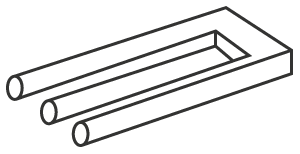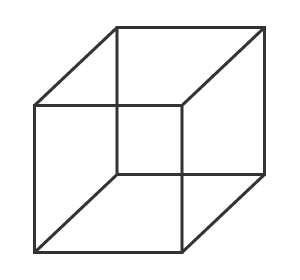Artist Statement
On Reflection
Paradox and Ambiguity
 An image of the impossible trident appeared on the cover of Mad magazine in the mid 1960’s. I found it fascinating but totally baffling. By covering a portion of the drawing it was possible to dissect how it was made but when viewed as a whole it remained vexing. How could this be? The visual ambiguity tantalized me. I’m still provoked by how I see and am fascinated when I fail to observe what is objectively there.
An image of the impossible trident appeared on the cover of Mad magazine in the mid 1960’s. I found it fascinating but totally baffling. By covering a portion of the drawing it was possible to dissect how it was made but when viewed as a whole it remained vexing. How could this be? The visual ambiguity tantalized me. I’m still provoked by how I see and am fascinated when I fail to observe what is objectively there.
I struggle with “confirmation bias” which suggests that I’m prone to perceive the world in a way that confirms my existing preconceptions rather than being open to greater depth of insight.
 The Necker cube demonstrates the relative nature of visual perception. At first look, the bottom square may appear closer but with continued viewing it switches and the top square appears closer. Our eyes send identical signals to the brain but the brain flip-flops over the interpretation. I’m interested in art that challenges my conventional seeing/thinking.
The Necker cube demonstrates the relative nature of visual perception. At first look, the bottom square may appear closer but with continued viewing it switches and the top square appears closer. Our eyes send identical signals to the brain but the brain flip-flops over the interpretation. I’m interested in art that challenges my conventional seeing/thinking.
My paintings attempt to challenge what “I think I see and know.” It requires careful and repeated looking and reflecting on what is being reflected. It requires observing the specific, rather than the general and it requires the suspension of what I think I know about a subject when that subject is seen as a reflection on an unpredictable surface. The challenge is to put down exactly the odd and unexpected shapes and colors that establish a convincing image by using a trompe l’oeil technique. I hope to bring together technique and idea – to create balance between the two.
The paintings reflect a point of view that almost nothing is what it first appears to be. I’m interested in layers of meaning and consideration of ambiguity and paradox beyond art.
Touchstones to the paintings
The question is not what you look at, but what you see.
Henry David Thoreau
I’m not just interested in what a thing is, I’m interested in what else it is.
Minor White
Nothing is as abstract as reality.
Giorgio Morandi